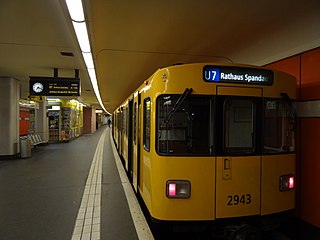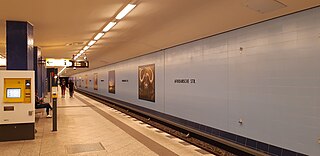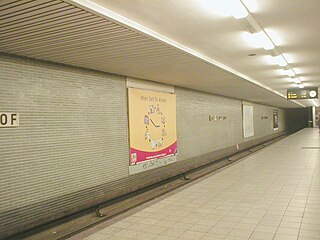
The Berlin U-Bahn is a rapid transit system in Berlin, the capital and largest city of Germany, and a major part of the city's public transport system. Together with the S-Bahn, a network of suburban train lines, and a tram network that operates mostly in the eastern parts of the city, it serves as the main means of transport in the capital.

U2 is a line of the Berlin U-Bahn. The U2 line starts at Pankow S-Bahn station, runs through the eastern city centre (Alexanderplatz) to Potsdamer Platz, the western city centre and finally to the Ruhleben terminal station.

U5 is a line on the Berlin U-Bahn. It runs from Hauptbahnhof in Mitte eastwards through Alexanderplatz, Friedrichshain, Lichtenberg and Friedrichsfelde, surfaces in Biesdorf-Süd to pass Kaulsdorf and Hellersdorf above ground and finally reaches city limits at Hönow.

U6 is a 19.9 km (12.4 mi) long rapid transit line on the Berlin U-Bahn with 29 stations. It runs in a north-south direction from the Berlin locality of Tegel in the north via Friedrichstraße to Mariendorf, a locality in the southern part of the city. It is one of the five large profile ("Großprofil") lines.

The U7 is a rail line on the Berlin U-Bahn. It runs completely underground for a length of 31.8 kilometres (19.8 mi) through 40 stations and connects Spandau, via Neukölln, to Gropiusstadt and Rudow. The U7 was originally the south-eastern branch of the Nord-Süd-Bahn (U6) that ran between the branching point at Belle-Alliance-Straße (Mehringdamm) and Grenzallee; however, in the 1960s, this stretch was separated from the rest of the line and extended at each end to form a new line.

Jakob-Kaiser-Platz is a metro station on the Berlin U-Bahn line U7, located in the Charlottenburg-Nord district. It was opened on 1 October 1980 with the line's extension from Richard-Wagner-Platz to Rohrdamm. The eponymous traffic circle located above the station is named after politician and Resistance fighter Jakob Kaiser (1888–1961). The next station going eastbound is Jungfernheide
The Munich U-Bahn is an electric rail rapid transit network in Munich, Germany. The system began operation in 1971, and is operated by the municipally owned Münchner Verkehrsgesellschaft. The network is integrated into the Münchner Verkehrs- und Tarifverbund and interconnected with the Munich S-Bahn. The U-Bahn currently comprises eight lines, serving 96 stations, and encompassing 103.1 kilometres (64.1 mi) of routes.

Hallesches Tor is a Berlin U-Bahn station in the central Kreuzberg quarter, served by lines U1, U3, and U6. It is named after the historic Hallsches Tor of the Berlin Customs Wall, erected in the 18th century.

Kurt-Schumacher-Platz is a station on the U6 line of the Berlin U-Bahn. There had been a bus link outside the station connecting Berlin's Tegel International Airport to the U-Bahn network. The station was opened on 3 May 1956 and named after famous German politician Kurt Schumacher.

Scharnweberstraße is a Berlin U-Bahn station located on the U6. It was constructed by B. Grimmek in 1958. Due to the extension of the U6, the trains had to go above ground after Kurt-Schumacher-Platz station. Soil for the embankment on which the line is built came from excavations for the U9, which was being built in parallel. As the trains had to go above ground, Berliner Verkehrsbetriebe (BVG), who operate the Berlin U-Bahn, had to install windscreen wipers on the trains.

Afrikanische Straße is a station in the Wedding district of Berlin which serves the U6 line and is operated by the BVG. The station is located under the Müllerstraße, one of the district's major shopping streets and thoroughfares, but named for another major street nearby. The BVG uses the station under the internal abbreviation Afr; the train station is 631 meters from the Kurt-Schumacher-Platz U-Bahn Station and 587 meters from the Rehberge U-Bahn Station.

Rehberge is a station in the Wedding district of Berlin which serves the U6 line and is operated by the BVG. The station is named for Volkspark Rehberge, the large public park approximately 500m away, a name which literally translates as '(Roe) Deer Mountains'. The station was opened on 3 May 1956, along with the rest of the route between Seestraße and Kurt-Schumacher-Platz.

Platz der Luftbrücke is a Berlin U-Bahn station located on the U6. It is located under Platz der Luftbrücke and the south end of Mehringdamm on the border between Kreuzberg and Tempelhof, near the former Tempelhof International Airport, and is now named for the square there with its memorial to the victims of the Berlin Airlift.

Alt-Tempelhof is a Berlin U-Bahn station on the U6. It is located under Tempelhofer Damm in the centre of the former village of Tempelhof, now a Berlin district within the borough of Tempelhof-Schöneberg. The station opened on 28 February 1966.

Ullsteinstraße is a Berlin U-Bahn station located on the U6 line. The station was designed by R. G. Rümmler and opened in 1966.

Berlin Potsdamer Platz is a railway station in Berlin. It is completely underground and situated under Potsdamer Platz in central Berlin. Regional and S-Bahn services call at the station, and it is also served by U-Bahn line U2.

Berlin Tegel is a railway station in Tegel, a locality of the Reinickendorf borough of Berlin. It is served by the S-Bahn line S25.

The North–South S-Bahn Tunnel is the central section of the North–South transversal Berlin S-Bahn connection crossing the city centre. It is not to be confused with the Tunnel Nord-Süd-Fernbahn, the central tunnel part of the North–South main line used by intercity and regional trains. The S-Bahn North–South line encompasses the route from Bornholmer Straße and Gesundbrunnen via Friedrichstraße and Anhalter Bahnhof to Papestraße and Schöneberg.

The Berlin U-Bahn originated in 1880 with Werner Siemens' idea to build an urban railway in Berlin. During the nine years after the German Empire was founded, the city's population grew by over one-third and traffic problems increased. In 1896, Siemens & Halske began to construct the first stretch of overhead railway. On 1 April 1897, the company began construction of an electric underground railway. The Berliner Verkehrs Aktiengesellschaft (BVG) was formed in 1928, and took over further construction and operation of the network. In 1938, the company was renamed Berlin Transport Company; the original acronym, however, remained. Since 1994, the BVG has been a public company.
The tracks of the Berlin subway are lines operated in the line traffic, operating distances, which serve only internal purposes, turn-off and turning plants and plants in the operating farms.






















